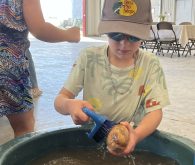From a city girl’s experience adapting to farm life to a widow’s tale of how she coped with the sudden loss, a panel of four at the recent Manitoba Farm Women’s Conference told how they overcame difficulties in hopes their insights and experience could guide others.
Pam Cavers
After Pam Cavers married her husband, Clinton, and moved from Winnipeg to Pilot Mound, Man., trouble brewed on the homestead.
“Once I moved out to the bush and quiet country, I realized that this was not going to be easy,” she said. “I came to the country with my own ideas. But I needed to open my mind and just learn from the get-go instead of thinking that I knew so much.”
Read Also

AgriStability updates offer stronger support for farmers
One of the most significant updates to the AgriStability program for the 2025 program year is the increase in the compensation rate.
Farming with her in-laws, Cavers said it became evident there were major differences of opinion about how best to go about it. Her interest in environmental issues and their farm’s impact on the land led to her, her husband and their three daughters striking out on their own.
“We started to see that we wanted to farm in a more sustainable way, and this did not mesh with Clinton’s parents,” she said. “We decided, after a lot of hurt, pain and words said that could not be taken back, that it would be better if we went our separate ways.”
After recovering from surgery for a cancerous growth in her lung, Cavers plunged back into farm and community life. The illness, and subsequent readjustment to family life, showed her that what was important was not the things that she did, but who she was.
A love for the land and animals helped her chart a new course for the farm that fits their values. As a member of the Harvest Moon Local Food Initiative, Cavers sees big changes afoot in the way farms market their produce. She appreciates the benefit of being part of a group of like-minded farmers.
“It started with the idea of doing things right,” she said. “Now we have over 20 producers on board, and all sorts of city folks interested in buying their food locally, and caring about what happens to it along the way.
“We are still changing and adapting to fit,” she said. “We want to leave something behind for our kids, but we don’t want it to be a footprint that can’t be cleaned away.”
Christi Van Den Bussche
A lot of hard work goes into community projects. Just how much is abundantly clear now to Christi Van Den Bussche.
When she and other young mothers in Treherne, Man., banded together in 2002 to set up a licensed subsidized day care in the town of 750, they got busy with fundraising through craft sales, community calendars, raffles and an unending list.
“We were all gestating, lactating, delivering or had little ones around our feet. So you can imagine that most of the meetings in those days had to be in someone’s basement with Little Tikes and Fisher Price,” she said.
The decision to build a new facility to house the day care, nursery school, and before and after school programs left them scouting out locations. They were able to lease some land for $1 from the local school division and work on building the facility that would include eight infant and 20 pre-school spots.
In the spring of 2003, they continued fundraising and developed a business plan and grant application for the facility. With the help of community leaders, an auction in the spring of 2004 raised $56,000 for the project in one evening.
Shopping for a $125,000 mortgage for a building on leased land proved to be difficult. Talks with the big banks proved fruitless, but local credit unions proved more amenable.
With 50 percent of the project cost in the bank already, Van Den Bussche needed guarantors to sign $5,000 promissory notes.
“Young women and young farm families with not a lot of collateral were not what the banks were looking for,” she said. “We basically hit the streets and beat some grandmas and convinced them to sign some notes. It all worked in the end.”
In early September 2005, the Tiger Hills Community Resource Centre’s doors were thrown open for the first time. A month later, the bid for annual funding was approved by the provincial government.
“Now, I’m proud to say that our $25,000 line of credit is paid off and signed guarantors have been released within seven months of operations,” she said. “After seven years of many sleepless nights, I’m leaving them in good shape.”
Ann Kroeker
After growing up the ninth of 12 children on a farm between Elm Creek and Portage la Prairie, Ann Kroeker’s dream was to live in Winnipeg.
“I had two dreams: one was to be a nurse, and the other was to live in Winnipeg,” she said, adding that one month before graduation from nursing school, it was announced that only 10 of the 100 students would get jobs at St. Boniface Hospital, and the rest would be “thrown to the wind.”
With part of her dream shattered, she found a job in a small town south of the provincial capital.
“If someone had told me that I would end up going to Winkler, I probably would have shot myself.”
Determined to move back to the city, for years she scoured the help wanted ads in vain.
“In the meantime, I found a wonderful man. There is only one thing wrong with this man: he hates Winnipeg,” she said.
The couple settled down in Altona, Man., and started a family. By 35, she woke up in the grips of a full blown clinical depression.
“Depression is nature’s way of telling you that something needs to change. The rest is details.”
With the help of friends and family, she reclaimed her life by rediscovering who she was.
“I think part of it was grief over the loss of my dreams. Reality was starting to set in. I was starting to realize that I was not going to convince this man who hated Winnipeg that we were going there.”
After a bout with cancer, beating depression and seven years as a stay-at-home mother, she re-entered the workforce in the field of community support services. Later, after serving on the school board, she fell in love with the up-and-down world of politics.
“The values that I learned on that little farm have remained as my guiding principles for me my entire life,” she said. “Openness, forgiveness and gratitude.”
Audrey Grier
Growing up on a farm in the 1930s, Audrey Grier was her father’s right hand man. That experience would help to prepare her for future challenges.
While working as a teacher, she married a dairy farmer from Dominion City, Man., in 1957. She raised three children as she continued to teach, milking a dozen cows each morning before school.
With specialization the buzzword in 1960s agriculture, she retired from teaching and they built up a herd of Brown Swiss cattle. They also travelled the show circuit, partly out of their passion for the breed, as well as for promotional purposes.
The children grew up and moved away, and they found themselves empty nesters, although still active in community life.
“We were starting to slow down and relax a bit. Life was good. We both were reasonably healthy and financially sound,” she said.
“Then July 1, 1989, at 9:30 a.m., my world crumbled. Two days prior to his death, Maurice had suffered from flu symptoms. He had a doctor’s appointment at 10:30 the day he died,” she said. “When I returned from milking, I found him sitting comfortably in his chair, asleep forever.”
News of a death travels fast in a small community, she said. Neighbours gathered around, as is rural custom. Forty acres of alfalfa lying in the swath was baled, without any request for help.
The hired man left for greener pastures, but her daughter, Candace, came back to the farm to help tend the 200 head of dairy cattle.
“We stumbled through the summer,” she said. “In the spring of 1990, I made up my mind to keep going. Thirty-three years of my life had been spent building the business. The dairying I knew; the land could be rented out.”
Her education started again. She learned to dicker with cattle buyers and shop for machinery. Candace bought out her siblings’ portions of the farm and a decade later has paid off her debts.
Succession planning is now the issue at hand, said Grier, who is unsure whether to remain as a lesser partner or phase out completely.
Since her husband died, Grier has travelled to New Zealand and Australia, and swam off the Great Barrier Reef.
“That was a great memory, because I’m not a swimmer,” she said. “But I had a very handsome lifeguard. I thought at that time, ‘you’re 65. If you’re ever going to do it, do it now.’ “














